This 1923 ad copy became more famous than the Jordan Playboy, the car it promoted:
SOMEWHERE west of Laramie there’s a bronco-busting, steer roping girl who knows what I’m talking about. She can tell what a sassy pony, that’s a cross between greased lighting and the place where it hits, can do with eleven hundred pounds of steel and action when he’s going high, wide and handsome. The truth is – the Playboy was built for her. Built for the lass whose face is brown with the sun when the day is done of revel and romp and race. She loves the cross of the wild and the tame. There’s a savor of links about that car – of laughter and lilt and light – a hint of old loves – and saddle and quirt. It’s a brawny thing – yet a graceful thing for the sweep o’ the Avenue. Step into the Playboy when the hour grows dull with things gone dead and stale. Then start for the land of real living with the spirit of the lass who rides, lean and rangy, into the red horizon of a Wyoming twilight.
The “west of Laramie” I have in mind today is the old Garfield Park “L” line that ran on the surface to Des Plaines Avenue in Forest Park. Looking back 55 years after scenes such as these disappeared, to be replaced by the Congress rapid transit line (today’s Blue Line), some of the poetry still seems apt. The “Sunset Lines” rode off into the sunset.
Here are some scenes showing this portion of the old Garfield Park line as it once was. At times, it can be a bit difficult to determine the exact location, but we know some of our readers will help out.
Although used by the CTA, this trackage was actually owned by the Chicago, Aurora and Elgin. CA&E and CTA’s predecessors swapped trackage rights in 1902- allowing CA&E to go downtown, and Met “L” cars west of Laramie. (East of Laramie, trains went up a ramp to steel structure the rest of the way downtown.)
Circa 1949-51, plans were being finalized to build the City of Chicago’s portion of the Congress Superhighway, which needed about half of the Garfield right-of-way for the road. The portion in direct conflict was relocated in September 1953 to temporary street-level tracks on Van Buren Street. The original plan was for a temporary wooden “L” structure in the same location, but a local alderman objected, voicing the concerns of local business owners. Not wanting to see the project tied up in litigation, the City caved and the street trackage was the result.
You might wonder why there were no grade crossings or gates on Van Buren, but at first the City referred to this as “streetcar trackage,” although none of it was. It used third rail throughout, except at major intersections, where there was a gap. I don’t think CTA could have found enough cars with trolley poles to run it with overhead wire.
CA&E liked the idea of a modern grade-separated right-of-way in the expressway median, and in 1951, predicted using it would shave several minutes off their running times. But alas, it was not to be.
Fearing the Van Buren operation would become a dangerous quagmire, CA&E refused to run their trains on it, meaning service would need to be cut back to a transfer point with CTA. Laramie would have been a logical place for this, since it was the point where CA&E’s tracks ended, but it suited both CA&E and CTA to shift the transfer point west to Des Plaines Avenue in Forest Park. CA&E allowed CTA to reconfigure the station to facilitate such transfers, where riders would need to pay a CTA fare and vice-verse. CA&E also insisted that the track connection between the two railroads be severed, to create an additional obstacle in case they were ordered to resume service downtown.
Destroying the track connection may have also played a part in the earlier abandonment of the CTA Westchester branch, which was also owned by CA&E. CTA was happy to substitute bus service (the #17, which lasted until a few months ago) and CA&E sold off the land in the rapidly developing area and gave the cash to their shareholders rather than reinvest it in the interurban. This was the first in a series of such land sales, which helped grease the skids for CA&E’s eventual abandonment.
There were conflicting press reports on whether CA&E would ever go back to running downtown, even after the completion of the expressway segment. But in exchange for selling the land between Des Plaines and Laramie to the State, CA&E was supposed to get its own express track in that section, so that its trains could be kept separated from CTA’s. By the time this section was built, CA&E had abandoned passenger service and the third track was never built. This track would have been north of where the current two-track right-of-way is today.
You can see a third portal on the tunnel east of Central Avenue, where the CTA line shifts into the expressway median. The extra portal may have had an additional use besides CA&E. While these plans were being made, CTA still anticipated needing to use Laramie Yard. If so, the City would have built a track connection between Laramie Yard and the rest of the Congress line, and this involved crossing the highway. Chances are this would have been the point at which a subway tunnel would have gone under the roadway, with a ramp up to the surface.
As it was, an at-grade track connection was retained to Laramie Yard for about one year after the eastern part of Congress opened in June 1958, but this of course kept the highway, which would have crossed it, at bay.
Once CA&E quit passenger service in 1957, indicating a willingness to sell the Des Plaines terminal land, plans were changed to make that the CTA terminal, yard, and shops facility for the line. Doing so saved the City the substantial costs of building a tunnel to Laramie Yard.
While expressway construction progressed in the City during 1953-58, the trackage at Laramie and points west was largely untouched. Once the Congress line opened in June 1958, the new portion of line ended near Laramie and then connected to the existing grade-level alignment going west, which included a junction where the line crossed the B&O freight line, now thankfully grade separated.
Once the eastern portion of the Congress line opened in 1958, work began on our featured section, with a series of shifting temporary rights-of-way and temporary stations before things reached final form in 1961. By this time, local transit activists had persuaded the CTA to add secondary entrances to the Austin, Oak Park, and Harlem stations, in part to make up for the reduction of the total number of stations in the area. Stations in odd places like Gunderson were eliminated.
Today we can enjoy riding the Blue Line rapid, while at the same time lament the loss of CA&E and wonder what might have been. Return with us now to those thrilling days of yesteryear in our photo essay, when life was a little bit slower and less hectic, in the days when the Garfield Park “L” ran on the ground, somewhere west of Laramie.
-David Sadowski
(All photos from the Author’s collection.)
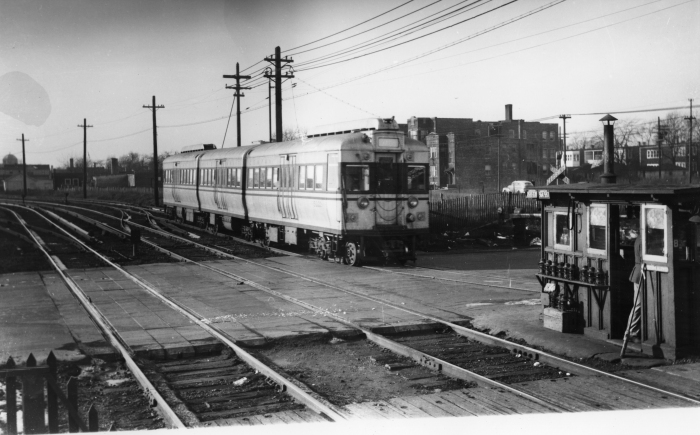
CTA 5002 westbound at Laramie, December 1947. The four experimental articulated cars were patterned after the earlier BMT “Bluebirds” in New York. While they were ordered by CRT in their waning days, the fledgling CTA and the City of Chicago stage-managed this behind the scenes, as they also did with the CSL order for 600 “Green Hornet” streetcars. Car 5001 was already on CRT property before CTA took over on October 1, 1947. (Photographer unknown)

CTA 6037-6038 heading west at Laramie on a CERA fantrip on May 1, 1955, showing how the line curved off a bit to the south, before straightening out temporarily to cross Lockwood before veering off again to run parallel with the B&O. We have attempted to bring the color back as much as possible in this early Ektachrome slide, which has a very pronounced “red shift.” (Photo by Ray DeGroote)
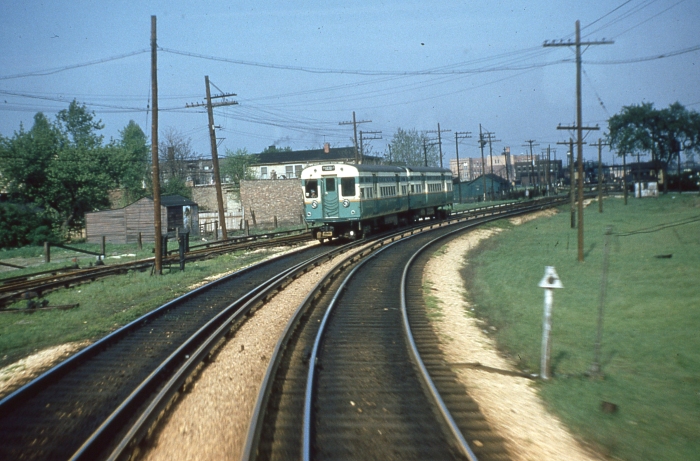
Here, just a bit west of the previous picture, we see the sweeping curve from the other perspective, looking east. Note the position of the shack at left in the other picture. May 9, 1954 (Photo by Ray DeGroote)
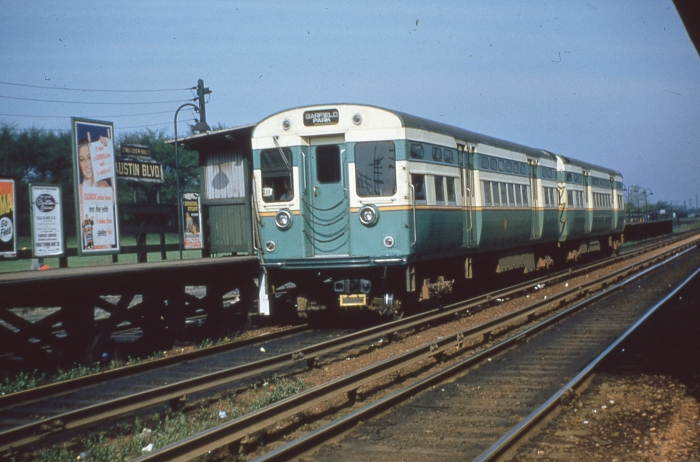
CTA 6042-6041 westbound at Austin Boulevard on May 9, 1954. (Photo by Ray DeGroote)
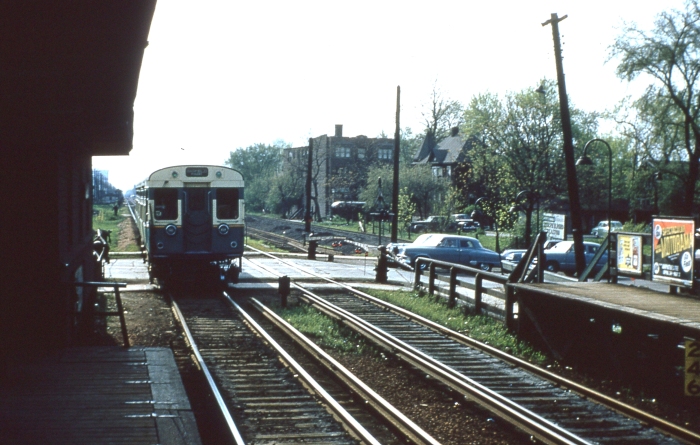
CTA 6055-6056 eastbound at Austin on May 9, 1954. (Photo by Ray DeGroote)

6000s eastbound at Austin in Oak Park on May 9, 1954. At right we see the large gas tank that was once a Forest Park landmark. (Photo by Ray DeGroote)

Looking east from DesPlaines avenue in Forest Park on March 18, 1956, near where the Garfield line crossed the B&O. (Photo by Ray DeGroote)

CA&E car 408 near DesPlaines avenue on October 16, 1955 (Photo by Ray DeGroote)
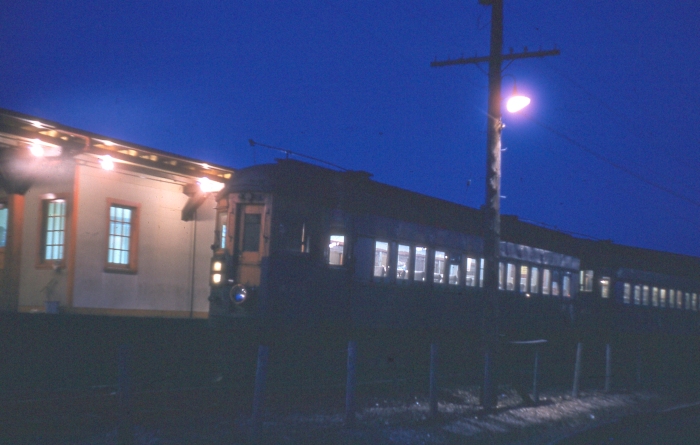
In this nighttime shot, a CA&E train sits at Des Plaines terminal in April 1957. (Photographer unknown)
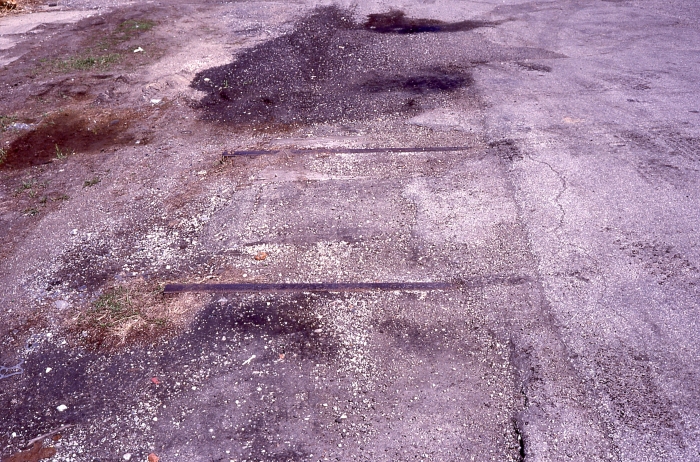
Perhaps the last remnant of the Garfield Park “L”, a bit of track peeks out through asphalt at the Lockwood crossing in this 1980s photo by David Sadowski.